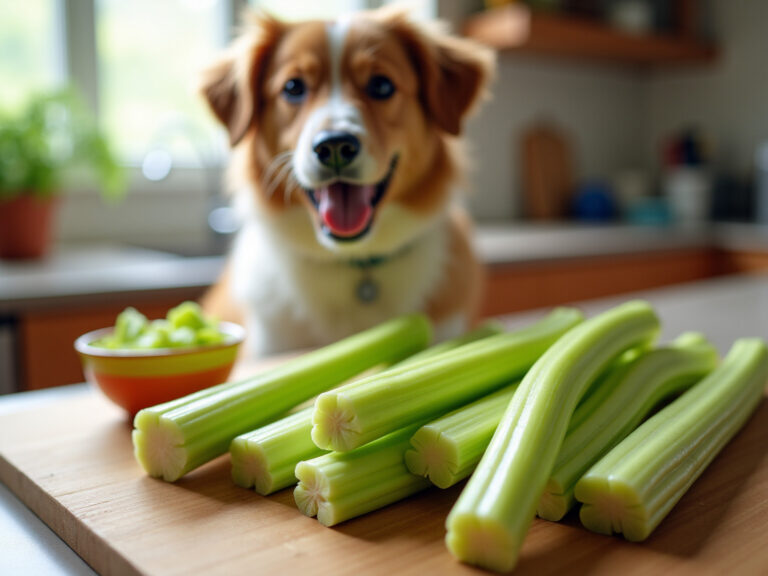Can Dogs Eat Cherries? Understanding Risks and Benefits
Overview
As a loving pet owner, you may wonder if your furry family members can enjoy cherries. The good news is that dogs can eat cherries in moderation! However, it’s crucial to remember that only the fruit’s pulp is safe for them. The pits, stems, and leaves contain cyanide, which can be toxic. To keep your pet safe, always remove these harmful parts and monitor for any adverse reactions.
Cherries can offer some nutritional benefits, but it’s important to treat them as an occasional treat. Their high sugar content can pose potential health risks if consumed too frequently. By being mindful and ensuring a nurturing environment, you can help your dog enjoy cherries safely while keeping their health in check. So, next time you indulge in this sweet fruit, share a little with your pup, but remember to do so responsibly!
Introduction
The allure of cherries, with their vibrant color and sweet flavor, often extends beyond human enjoyment to our furry family members. While the flesh of this beloved fruit can be a delightful treat for dogs, it is essential to exercise caution. Not all parts of the cherry are safe; the pits, stems, and leaves contain cyanide, which poses serious health risks. This article explores the intricacies of cherry consumption for dogs, highlighting the nutritional benefits, potential dangers, and essential safety guidelines for pet owners. By understanding how to safely introduce cherries into your dog’s diet, you can ensure your four-legged friends enjoy this tasty fruit without compromising their health.
Understanding Cherry Consumption in Dogs
Cherries are a beloved fruit, celebrated for their sweet taste and nutritional value. For your furry family members, it is important to know if can dogs eat cherries, as the meat of the fruit can serve as a suitable snack when provided in moderation. However, it’s essential to acknowledge that when considering whether can dogs eat cherries, not all sections of the fruit are safe for canine consumption. The pits, stems, and leaves contain cyanide, presenting a considerable toxicity threat to dogs.
Therefore, if you choose to share these fruits with your dog, it is crucial to eliminate these harmful elements entirely, particularly when considering the question, can dogs eat cherries, as the pulp is generally safe, but pet owners should exercise caution. Even small quantities of the fruit can lead to health concerns, especially if the pits are consumed. Statistics indicate that even a slight increase in weight from treats can elevate a dog’s risk of developing serious health issues, including diabetes and heart problems. This highlights the importance of moderation and thoughtful evaluation when introducing any new food into your dog’s diet, particularly in light of recent discussions among veterinarians on the topic of can dogs eat cherries.
Experts recommend steering clear of canned fruit due to added sugars and preservatives, which can complicate your dog’s health. As a responsible pet owner, it’s vital to stay informed about foods suitable for your furry friend, including whether can dogs eat cherries. By recognizing the risks and ensuring secure practices, you can enjoy the occasional fruit treat with your dog while prioritizing their health and well-being.
At Adventure Den, we emphasize the importance of safe treat practices in a nurturing environment. Our commitment to providing exceptional care ensures that every dog enjoys their time with us while staying healthy. Many dog owners have shared their experiences of giving their pets fruits from the Prunus avium species, but it’s essential to proceed with care. By cultivating a secure and stimulating environment, we assist pet owners in making informed choices regarding their pets’ diets, ensuring that each visit is a joyful experience for animals and reassurance for their owners.
Identifying Risks and Toxicity of Cherries for Dogs
As a loving pet owner, it’s important to be aware of the potential dangers that certain fruits can pose to your furry family members, especially when considering the question of can dogs eat cherries. The main risk comes from the cyanide levels found in the pits, stems, and leaves of these fruits. Ingesting these parts can lead to cyanide poisoning, which may manifest as:
- Difficulty breathing
- Dilated pupils
- Bright red gums
While the fruit’s pulp is safe for dogs, it’s crucial to restrict access to the harmful elements. Even small amounts of cyanide can pose significant health risks, so vigilance is key.
Additionally, some dogs may have allergic reactions to specific fruits, which can include:
- Hives
- Rashes
- Vomiting
- Diarrhea
This underscores the need for caution when allowing your pets access to these foods. As Team Mesa points out, “Though risky (for all the reasons we have mentioned above), these fruits do provide several nutritional advantages that could benefit both your health and your dog’s.”
If you suspect your dog has consumed a pit from a fruit, it’s vital to seek veterinary consultation immediately. Prompt action can significantly reduce the risks associated with cyanide exposure. A case study titled “Veterinary Response to Cherry Pit Ingestion” highlights how quick responses can safeguard a dog’s health. Statistics show that there have been numerous reported cases of cherry-related toxicity in dogs, which raises the question of whether can dogs eat cherries, emphasizing the importance of awareness and prevention strategies to keep your pets safe from these potentially harmful fruits.

Nutritional Value and Health Implications of Cherries for Dogs
Cherries are a nutrient-dense fruit, brimming with vitamins A and C, fiber, and antioxidants, all of which can significantly enhance your furry family member’s health. These essential nutrients play a crucial role in reducing inflammation, strengthening the immune system, and supporting healthy digestion.
However, due to their high sugar content, the question of can dogs eat cherries should be considered, as they are best viewed as an occasional treat rather than a regular part of your dog’s diet. Remember, treats—including fruits—should make up no more than 10% of your dog’s daily caloric intake to ensure a balanced diet. Overindulgence can lead to gastrointestinal issues, such as diarrhea, highlighting the importance of moderation.
It’s vital to monitor your dog’s fruit intake, not only to prevent potential risks associated with pits but also to maintain a well-rounded diet. While cherries can be a nutritious treat, it’s always wise to consult with your veterinarian to answer the question of whether can dogs eat cherries safely in their meals.
As The Adored Beast Team wisely advises, “Only ever give fresh fruits to your pup.” By prioritizing health and keeping a close eye on consumption, you can allow your pets to enjoy the benefits of these fruits without the associated risks.
Additionally, consider safe substitutes for cherries, such as:
- Watermelon
- Pineapples
- Peaches
- Strawberries
- Bananas
Offering a delightful range of fruit choices for you to explore with your beloved pet.
Guidelines for Safe Cherry Consumption and Emergency Responses
To safely introduce fruit to your furry family members, it’s essential to remove all pits, stems, and leaves before offering any. Begin by providing a small piece of fruit flesh and closely monitor your dog for any signs of digestive distress, such as vomiting or diarrhea. If your dog accidentally ingests pits from cherries, which can pose serious health risks, or shows symptoms of cyanide poisoning—like difficulty breathing or lethargy—seeking prompt veterinary assistance is crucial. Keep your veterinarian’s contact information and that of a local emergency animal clinic readily accessible for peace of mind.
For life-saving measures, don’t hesitate to contact the Pet Poison Helpline at (855) 764-7661. A case study titled ‘Final Verdict on Dogs Consuming Fruits’ underscores the importance of caution when feeding fruits to dogs. It’s vital to be aware of signs of gastrointestinal blockage from fruit pits, which may include:
- Constipation
- Decreased appetite
- Vomiting
If you observe any of these symptoms, a vet visit is necessary. By following these guidelines, pet owners can enjoy the potential benefits of cherries while effectively minimizing associated risks, particularly by understanding if can dogs eat cherries safely for their beloved companions. Remember, your dog’s safety and well-being are of utmost importance, and taking these precautions will help create a nurturing environment for them.
Conclusion
Cherries can be a delightful and nutritious treat for your furry family members when offered with caution and care. The flesh of the cherry is safe and packed with vitamins, antioxidants, and fiber, which can contribute positively to your dog’s health. However, it is crucial to remember that the pits, stems, and leaves contain cyanide, posing serious health risks if ingested. As a responsible pet owner, you must ensure these toxic components are entirely removed before sharing cherries with your beloved companions.
Moderation is key when introducing cherries into your dog’s diet. Even small amounts can lead to health complications, particularly if the pits are accidentally consumed. Maintaining a balanced diet is essential, and cherries should only make up a small percentage of your dog’s daily caloric intake. By prioritizing health and being vigilant about potential allergic reactions or digestive issues, you can safely allow your dogs to enjoy this sweet treat.
In conclusion, understanding the risks and benefits associated with cherry consumption is vital for responsible pet ownership. By following safety guidelines and being proactive in monitoring your dog’s health, you can ensure that cherries remain a safe and enjoyable part of their diet. With the right precautions, cherries can be a delightful indulgence that contributes to your dog’s well-being without compromising their health.
Frequently Asked Questions
Can dogs eat cherries?
Yes, dogs can eat cherries, but only the pulp of the fruit. The meat of the cherry can serve as a suitable snack when provided in moderation.
What parts of the cherry are unsafe for dogs?
The pits, stems, and leaves of cherries are unsafe for dogs as they contain cyanide, which poses a significant toxicity threat.
How can I safely give cherries to my dog?
If you choose to share cherries with your dog, it is crucial to remove the pits, stems, and leaves completely to avoid any health risks.
What health risks are associated with feeding cherries to dogs?
Even small quantities of cherries can lead to health concerns, particularly if the pits are consumed. Additionally, weight gain from treats can increase the risk of serious health issues, such as diabetes and heart problems.
Are canned cherries safe for dogs?
No, it is recommended to avoid canned cherries due to the added sugars and preservatives, which can negatively affect your dog’s health.
What should pet owners keep in mind when introducing new foods to their dog’s diet?
Pet owners should exercise caution and prioritize moderation when introducing any new food, including cherries, into their dog’s diet, and stay informed about suitable foods for their pets.
How does Adventure Den support pet owners regarding their dogs’ diets?
Adventure Den emphasizes safe treat practices and provides exceptional care, helping pet owners make informed choices about their pets’ diets to ensure a healthy and joyful experience for their dogs.







